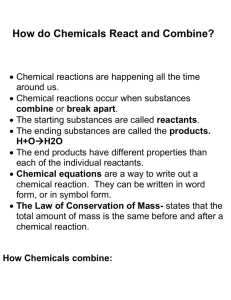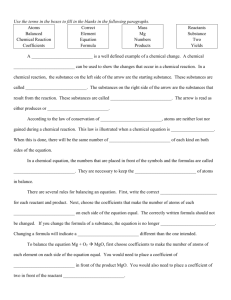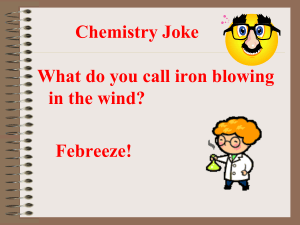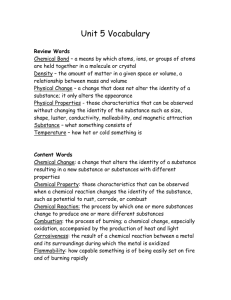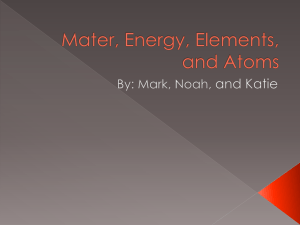Chemical Reaction
advertisement
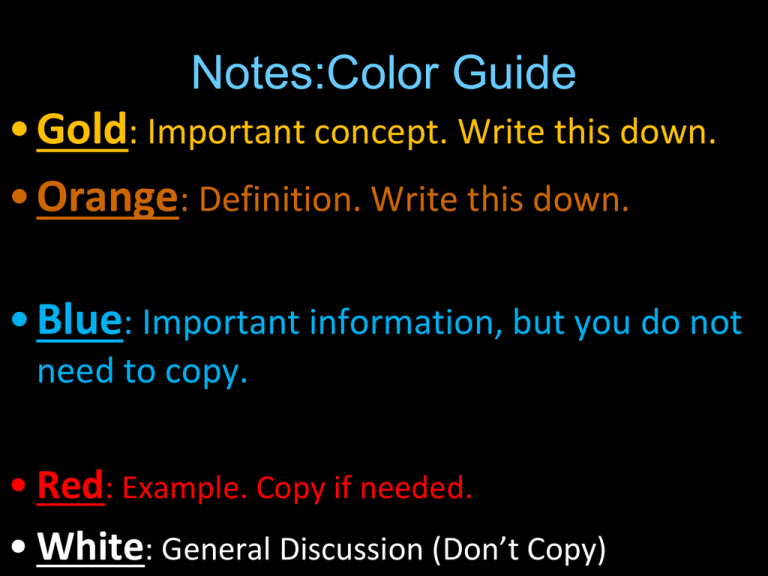
Notes:Color Guide • Gold: Important concept. Write this down. • Orange: Definition. Write this down. • Blue: Important information, but you do not need to copy. • Red: Example. Copy if needed. • White: General Discussion (Don’t Copy) Chapter 6: Chemical Reactions Section 1: Forming Compounds • Definition: chemical reaction – the process that causes a substance to change into a new substance. – Chemical reactions cause atoms to REARRANGE. – One example of a chemical reaction occurs when cations join with anions. Chemical Reaction Ionic compounds form when cations and anions bond together. • When ionic compounds form, the new compound must have no charge. In other words, all of the + and - charges must cancel out. Charged Charged Neutral! Each cation and anion has it’s own charge. Lets look at the cations first. Please copy into your notes. Use only the element symbols. Group 1 1+ Charge Group 2 2+ Charge Group 13 3+ Charge Lithium: Li1+ Beryllium: Be2+ Aluminum: Al3+ Sodium: Na1+ Magnesium: Mg2+ Potassium: K1+ Calcium: Ca2+ Rubidium: Rb1+ Strontium: Sr2+ Cesium: Cs1+ Barium: Ba2+ Francium: Fr1+ Radium: Ra2+ And now for the anions: • When a nonmetal becomes an anion, it’s name changes. – Example: Fluorine Fluoride – Example: Oxygen Oxide Group 17 1- Charge Fluoride: F1- Group 16 2- Charge Oxide: O2- Group 15 3- Charge Nitride: N3- Chloride: Cl1- Sulfide: S2- Phosphide: P3- Bromide: Br1- Selenium: Se2- Iodide: I1Astatine: At1- In order to form the new compound, the anions and cations must cancel each other’s charg. What happens if the charges DON’T cancel out??? • To make Sodium Oxide, there must be enough Sodium Cations to balance the Oxygen Anion. Why don’t we add another sodium cation to the reaction? Na1+ Na1+ O2- Na2O1 It took 2 Sodium to balance the 1 Oxide. • Lets try another one. How about Magnesium Chloride? Mg2+ Cl1Cl1- Mg1Cl2 It took 2 Chloride to balance the 1 Magnesium. • This stuff is actually pretty easy… Try these on your own: •Aluminum Bromide AlBr3 •Calcium Nitride Ca3N2 One more thing to remember…the metal always comes first. It keeps its original name. The nonmetal comes second. It changes it’s name. Easy! • Covalent compounds are named based on the number of atoms they contain. 1 2 3 4 5 6 7 8 – Prefixes are used to represent the number of atoms. The Prefixes Are: Rules: Mono •If the first element has only one Di atom, it gets no prefix. Tri •The first element uses it’s original Tetra name. Penta Hexa Hepta Octa Examples: • Carbon Di-oxide • Di-Hydrogen Di-oxide • Sulfur Tetra-Chloride Chapter 6: Chemical Reactions Section 2: The Nature of Chemical Reactions There are often signs that a chemical reaction is taking place: – Color Change – Gas Production (bubbling) – Energy Transfer (getting hot or cold, glowing) – These signs indicate that something is being changed & new substances are forming. So, in a chemical reaction…things REACT to PRODUCE other things. • Definition: reactants – the substances in a chemical reaction that are changed. • Definition: products - the NEW substances produced in a chemical reaction. – The product must contain the same elements as the reactant. Hydrogen C8H18 + O2 Carbon Hydrogen Carbon Oxygen H2O + CO2 Oxygen During a chemical reaction, atoms are rearranged. Lets look at the reaction of gasoline and oxygen again… – It would be far to dangerous to use gasoline as a fuel if it immediately reacted with oxygen, right? – What do we need in order to start the reaction? A SPARK! • Some chemical reactions need energy in order to begin. – Energy breaks the atomic bonds and allows the atoms to rearrange. – Once the bonds are broken, the reactants rearrange into the products. Perhaps the most important rule in chemistry is: • Definition: Law of Conservation of Mass – states that “In a chemical reaction, mass is never created or destroyed.” – In other words, you MUST have the same number of atoms in the reactant as you have in the product. Some reactions release energy as they occur… – Definition: exothermic change – a physical or chemical change that releases energy. •Exo. changes make the air warmer or give off light (or both). •Examples: combustion and condensation Some reactions absorb energy as they occur… –Definition: endothermic change – a physical or chemical change that absorbs energy. •Endo reactions lower the temp. •Examples: evaporation Chapter 6: Chemical Reactions Section 3: Types of Reactions • Definition: chemical equation – a representation of a chemical reaction using element symbols. – The means “yields” or “produces”. Chemical reactions are classified based on what happens to the reactants. Some reactions break the reactants apart… Others causes them to join together. Others just make them change places. • When things combine together in a chemical reaction, we call it “synthesis”. • Definition: synthesis reaction – a reaction in which two or more substances combine. • The general formula is: –A + B AB • A and B represent the reactants… • AB represents the product. When a chemical reaction breaks substances apart, it is called “decomposition”. • Definition: decomposition reaction – a reaction in which a compound breaks down into simpler substances. The general formula is: AB A+B • AB represents the reactant. • A + B represent the products. In replacement reactions, substances change places. • Definition: single replacement reaction – a reaction in which one element takes place of another to form a new compound. –The general formula is: –AX + B BX + A – Definition: Double Replacement reaction – a reaction in which two elements trade places. –The general formula is: –AX + BY AY + BX Notice that X takes the place of Y and Y takes the place of X. • Definition: combustion reaction – an exothermic reaction in which oxygen is (usually) a reactant. – Combustion reactions often produce H2O and CO2 as products.


